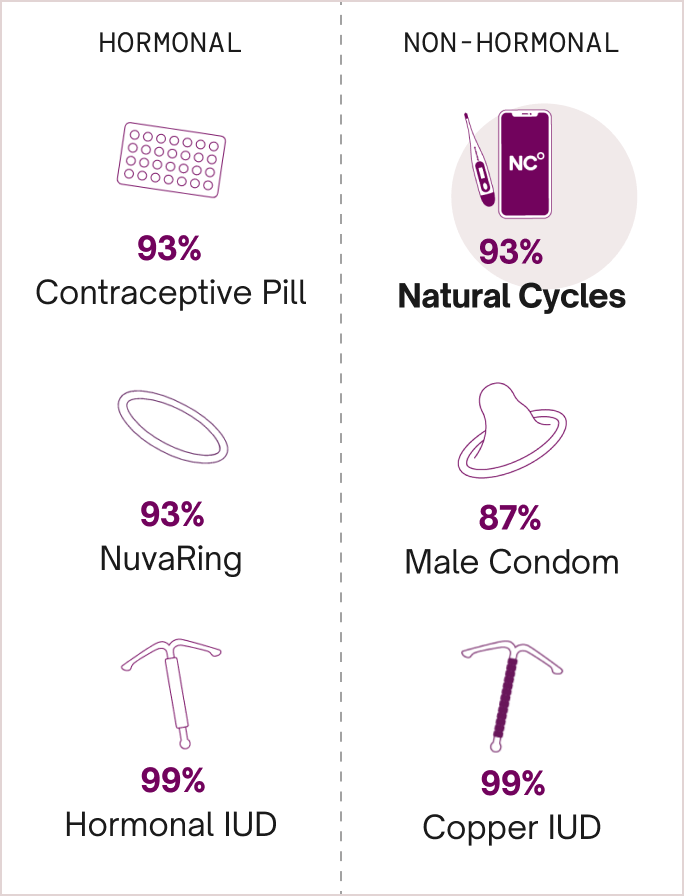Do you ovulate on birth control pills?
Key takeaways:
- The combined birth control pill contains synthetic hormones that change how the menstrual cycle works and stop ovulation
- The progesterone-only pill contains fewer hormones, and some people will still ovulate on this method
- Emergency birth control works by delaying ovulation and, in some cases, can stop a fertilized egg cell from implanting
Birth control and ovulation
Unlike natural birth control methods, hormonal contraception changes the way the menstrual cycle works in order to prevent pregnancy. In most cases, this involves suppressing ovulation (the release of a female egg cell). Without an egg cell to fertilize, pregnancy can’t happen, and sperm will simply die in the reproductive system.
How does the pill prevent pregnancy?
The hormones in birth control pills are essential to how they prevent pregnancy. There are two types of birth control pills, both are 93% effective at preventing pregnancy with typical use, but they work in slightly different ways:
The combined pill and ovulation
The more commonly prescribed combined pill contains the synthetic hormones estrogen and progesterone. It’s normal for this birth control method to stop ovulation entirely if it’s used as instructed. The combined pill can also thicken cervical mucus as a way to prevent pregnancy, this makes it harder for sperm cells to travel through the female reproductive system.
The progestin-only pill and ovulation
Sometimes called the mini pill, the progestin-only pill prevents pregnancy in several ways, by:
- Suppressing ovulation
- Thickening cervical mucus
- Thinning the lining of the uterus
You’re more likely to ovulate while taking the progesterone-only pill, but you’re protected in more ways with this method, so as long as you take it at the same time and follow the instructions, you are equally protected as those taking the combined pill. This type of pill is usually prescribed for those who can’t take birth control containing synthetic estrogen.

Emergency birth control and ovulation
Emergency birth control pills work a little differently to their daily counterparts. If you’ve had unprotected sex, you can take a morning-after pill (such as Plan B or Ella) up to five days after unprotected sex, but it’s best to take it as soon as possible. This pill works in several ways to reduce the chances of pregnancy, including delaying ovulation. This means if you’ve already ovulated and had unprotected sex, methods like Plan B might not work as an emergency birth control.
If you want a longer-term solution than a one-time pill, you can opt for a copper IUD. This can be fitted up to five days after unprotected sex and is more than 99% effective as a birth control method. It is the most effective form of emergency birth control and can stop fertilized egg cells from implanting, even if you’ve already ovulated. Once inserted a copper IUD can be used to prevent pregnancy for as long as ten years.
When you might ovulate on the pill
If you’re taking the combined pill, there are a few instances when you may ovulate while taking it. For example, if you forget to take the pill and the hormones wear off, then you may ovulate. There are also certain types of medication that can stop the pill from working properly, in which case you may ovulate too. It’s always important to read the instructions that come with your pill packet to find out exactly what can affect its effectiveness as a birth control method.
As mentioned above, you might also ovulate if you take the progestin-only pill, this is why it’s important to take it at a similar time each day as the hormones in the pill also work in other ways to stop you from getting pregnant. For example, if you ovulate and a sperm cell fertilizes the egg cell, this is unlikely to implant into the uterus wall because the hormones in the progestin-only pill work to thin the lining of the uterus.
If you have questions about the type of pill you’re using, how it works, or whether or not you’re likely to ovulate while using it, it’s best to talk to your doctor.
Find your ovulation with Natural Cycles
Whether you’re learning about this topic for the first time or you’re an expert on your menstrual cycle, at Natural Cycles we’re dedicated to supporting everyone’s fertility journey.
Natural Cycles is a temperature-based birth control method that works by finding your fertile window and identifying your ovulation day. The algorithm does this by pinpointing the rise in temperature that happens after ovulation and using this data to confirm and predict ovulation. You’re then assigned Red (fertile) or Green (non-fertile) days depending on where you are in your cycle. On Red Days, you can use condoms or abstain from sex to prevent pregnancy, and on Green Days, you’re not fertile and don’t need to use protection.
This temperature-based method works not only as natural birth control but can also be used to plan pregnancy, as once you know when you’re likely to ovulate, you can time sex to increase your chances of conceiving. Ready to say goodbye to synthetic hormones and their side effects? Find out if Natural Cycles could work for you today!
Did you enjoy reading this article?



